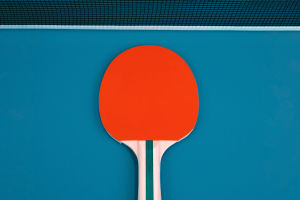Precision in Every Bounce
Table tennis is a sport that has gained immense popularity worldwide.
Its appeal lies in its simplicity—requiring minimal equipment—and the efficiency of its training, making it accessible to people of all ages and skill levels.
Despite the widespread enthusiasm for the game, many enthusiasts and casual players alike know little about the small ball at the center of the action.
The Evolution of Table Tennis Ball Materials
Initially, table tennis balls were crafted from rubber. However, as technology advanced, the primary material shifted to celluloid—a lightweight and moderately elastic plastic. Celluloid offers the ideal balance of speed and spin when struck, contributing to the sport's fast-paced nature.
The typical weight of a table tennis ball is around 2.7 grams, which allows it to generate significant air resistance, thereby influencing its trajectory in flight.
In recent years, another material, polyester fiber, has started to replace celluloid in the manufacturing of table tennis balls.
Environmental concerns largely drive this shift, as polyester fiber is more eco-friendly and easier to produce on a large scale. Polyester fiber balls offer better durability and elasticity and align more closely with the demands of modern competitive sports.
The Precision of Table Tennis Ball Production
The production of table tennis balls is a highly specialized and meticulous process. It begins with the heating of the raw material until it becomes pliable. Once softened, the material is molded into two hemispheres using a hemispherical mold.
These hemispheres are then bonded together using a specialized adhesive to form a complete sphere. This bonding process is crucial, as it ensures the ball's structural integrity.
After the ball is formed, it is heated to solidify the bond between the hemispheres. The ball is then placed in a high-speed rotating machine, where it is polished to ensure a smooth, round surface. This step is vital for maintaining consistency in the ball's performance during play.
Quality control is a critical aspect of the production process. Each finished table tennis ball must meet stringent criteria, including weight, diameter, and elasticity. A standard table tennis ball has a diameter of approximately 40 mm and weighs 2.7 grams.
To test its elasticity, the ball is dropped from a height of 30 cm, and its rebound height must fall between 23 and 26 cm. Only balls that pass these rigorous tests are deemed suitable for packaging and distribution.
The Impact of Physical Properties on Gameplay
The physical properties of table tennis balls play a pivotal role in shaping the dynamics of the game. One of the most significant characteristics is the ball's lightweight nature, which makes it highly susceptible to external forces.
During a match, players can manipulate the ball's spin by adjusting the angle and force with which they strike it. This spin, in turn, affects the ball's trajectory and landing point, introducing a level of unpredictability and excitement to the game.
Elasticity is another key factor that influences the outcome of a match. The ball's elasticity directly impacts its rebound height and speed.
Skilled players can adapt their playing techniques based on the ball's elastic properties to gain a competitive edge. For instance, they might vary their strokes to exploit the ball's bounce, thereby enhancing their chances of winning points.
Interestingly, the surface of a table tennis ball is not entirely smooth. It features a layer of fine textures, which are instrumental in facilitating spin when the ball is struck.
These textures also increase the ball's air resistance, further affecting its flight path. This combination of spin and air resistance is what makes table tennis a sport of strategy and precision, where every shot can be a game-changer.
While table tennis might appear to be a simple game, the intricacies involved in the design and production of its central component—the ball—reveal a deeper complexity. As the sport continues to evolve, so too will the technology behind it, further enhancing the experience for players and fans alike.
Whether you're a seasoned player or a casual observer, the humble table tennis ball is a reminder of the fascinating blend of science, skill, and strategy that defines this globally beloved sport.


